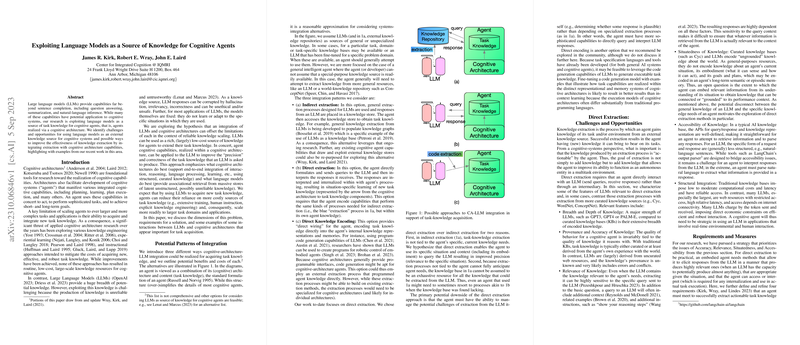Introduction to Cognitive Agent Knowledge Acquisition
Cognitive architectures serve as significant tools in the development of intelligent systems — cognitive agents imbued with capabilities such as decision-making, planning, and learning. A recurrent challenge impeding their scalability has been the acquisition and integration of new knowledge to execute increasingly complex tasks in diverse domains. The potential of LLMs as a substantial knowledge repository offers a promising avenue but comes with its own set of challenges, such as data reliability and relevancy.
Integrating LLMs with Cognitive Architectures
This integration hypothesizes a synergistic relationship between the structural advantages of cognitive architectures and the extensive knowledge base of LLMs. Cognitive architectures contribute structured, context-aware processing abilities, while LLMs bring in the capacity for broad knowledge retrieval. The direct extraction of task knowledge from LLMs to cognitive agents can potentially bypass the limitations inherent in each approach when working in isolation.
Direct Extraction Approach
One proposed solution centers on direct extraction, where cognitive agents interact with LLMs to fulfill specific knowledge gaps. This entails the agent formulating queries tailored to context and processing the received LLM responses. Such interaction demands that responses from LLMs satisfy criteria such as interpretability, grounding to situational context, compatibility with agent affordances, and alignment with human expectations.
Implementation and Evaluation
Researchers have applied a step-wise method to leverage direct extraction, using a combination of template-based and few-shot prompting to elicit meaningful responses from LLMs. Verification of the knowledge obtained is crucial, involving processes like query refinement and human evaluation to ensure the applicability and correctness of the responses. The strategy utilized sees the agent identify knowledge gaps, prompt the LLM with tailored queries, analyze responses, and ultimately integrate verified knowledge.
Conclusion
Initial experimentation underscores the need for rigorous response evaluation to ensure reliable learning. The analysis also suggests that integrating various knowledge sources within task learning could minimize dependencies on human oversight, indicating a fruitful pathway for cognition-driven systems. The full realization of this integrated approach, encompassing all facets of task learning, remains a rich field for future exploration.
